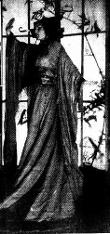
Latest Issues
AbstractHistoryArchive Description
Based on traditional Chinese ‘Rice Sprouting Songs’, Woman Song begins with the end of a Little Maiden’s visit to her brother. Married against her will following the wishes of her deceased parents, she dreads returning to her cruel mother-in-law. Although she begs her Elder Brother to allow her to stay with him, he counsels her to “put up with what Heaven has assigned to [her],” and wait for her life to change as she grows older.
See further down for production details and author's note.
Characters
AN ACTOR
AN ACTRESS
Notes
-
Author's note:
"Woman Song" was first done on August 12, 13, 18 and 19, 1932 at the Ab-intra Studio, in Adelaide, South Australia. It formed part of a full-length programme, interpreting phases of Old Japan, this despite "Woman Song" being really Chinese. However, the Studio felt that the two cultures were sufficiently alike traditionally to allow "Woman Song" to be included.
Later, in April 1942, it was bought by the Australian Broadcasting Corporation, after I had added the sub-title "A Play of Unchanging China," and written into the script sound-effects such as we had used in the original Ab-intra performances. Also, I wrote an introduction to be spoken by an announcer which extended the entire broadcasting time of "Woman Song" to about fifteen minutes. In their letter to me of acceptance, dated the 13th of April and signed by F D Clewlow, they say:
"The difficulty about such a short piece us that we can only programme it as a novelty but we shall let you know when we manage to fit it into some play bracket or other."
"'Woman Song' is presumably based on some actual traditional Chinese play; it would help us if you could let us have some information about the play's source."
In my answer to that, I wrote in my letter of April 19th as follows:
"'Woman Song' is believed to have originated as far back as 950 A.D. It is said that to encourage the cultivation of rice, which at that time was newly introduced, special songs and lyrics were composed, known as 'Rice Sprouting Songs,' a name they still bear. As centuries passed, they developed into a type of folk-drama which is today danced or acted to the accompaniment of instrumental music and with gaily costumed performers. "
"It will be seen from this that 'Woman Song' is based on a traditional Chinese play of considerable antiquity, and that it is still acted. All that I can add is that this particular play is believed to have originated beyond the north gate of the District Seat of Tinghsien made by a certain Kwei Chen; but who he is I have not any idea. As his name would probably convey no more to listeners than it does to me, I have thought it would serve no purpose to mention him. Attached hereto, however, is a short description of how such plays are done, and which may be of some use if you wish to lengthen or alter the Narrator's introduction in any way. It is from Nora Waln's book, 'The House of Exile'. "K.B. Corfu, 26/3/81
Extract from Nora Waln's "The House of Exile."
"The players were from Peking. They were all men. But they filled the women's parts with such skill that I did not know until long afterwards that they were men. The plays were given on a stage without scenery, as plays were given in Shakespeare's time. But so vivid was the acting that it created the impression of background.
There was never any hesitation or demur from the players. They seemed to have all the plays in their heads and all the necessary costumes in their boxes. With slight intervals for refreshment, the players went on until the star Canopus was clear in the heavens. After sunset the stage was lit by flaming pine knots in iron baskets, held high at each end of the stage, and tended by Camel-back (a servant.)
In the civil plays the orchestra led off with a single skin drum, followed in succession bu the castanets, the flutes, the pipe flageolets, the balloon guitar, the reed organ, the two-stringed violin, the chiming gong, and the small kettle-drum. The military plays were announced by a march played on the large drum, and the small gongs, followed by the cymbals and the clarionets. When the actors played sad parts, the orchestra was slow, low and plaintive. When humour was acted, then the accompaniment was a quick laughing rhythm. And when justice triumphed over wrong, the musicians made their instruments sing the victory. "
Production Details
-
- First produced by the Ab-intra Studio Theatre in August 1932.
- Performed at the Ab-intra Studio in Adelaide.
- First produced by the Ab-intra Studio Theatre in August 1932.
Publication Details of Only Known VersionEarliest 2 Known Versions of
-
cChina,cEast Asia, South and East Asia, Asia,
-
cChina,cEast Asia, South and East Asia, Asia,



